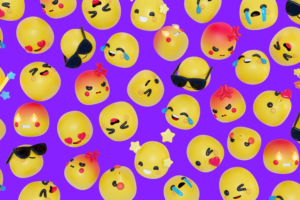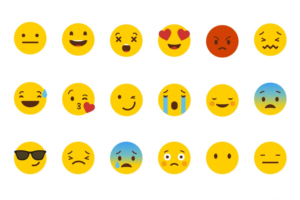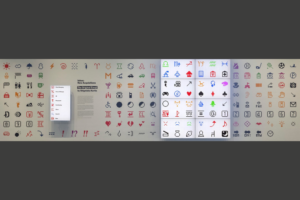
Source: Freepik
Everyone knows them and almost everyone has used them at some point – welcome to the world of emojis!
But when did emojis come into existence and what exactly is the difference between emojis and emoticons and what does emoji mean?
We answer these and many other questions in the following blog post.
What Is an Emoji?

Source: Freepik
The word emoji originally comes from Japanese and means “picture character”. A picture character means that something is represented as a picture instead of writing out a word. Simply put, a smile is shown as a picture and not the word smile written out. Fun fact: The word emoji is now used so frequently that it has been included in the dictionary. [1]
The History of Emojis
The origins go way back in history. During excavations, a bizarre drinking vessel with a semicircle and two dots was found, which was used 4000 years ago in the Bronze Age. As it stands, this is therefore the oldest smiley face in the world. It was only a long time later that the granddaddy of emojis was designed by Harvey Ball. In 1963, Harvey Ball was asked to design a symbol to improve the morale of an insurance company and developed a yellow circle with two dots and a semicircle. The granddaddy of all emojis was expanded in 1982 by the so-called emoticons. They were based on the design by Harvey Ball and were developed by Scott Fahlmann. [2]
Emoji vs. Emoticon
What is better known to us today as an emoji used to be the emoticon. It was developed by Scoot Fahlmann to make it easier to interpret chat messages. The computer science professor and his team found it difficult – and it is still just as difficult today – to interpret messages without an emoji or emoticon. The distinction between sarcasm, humor, joy or anger is sometimes very difficult to read between the lines. The emoticon invented by Fahlmann consists of a combination of characters that represent facial expressions when you turn your cell phone sideways, for example. So “:-)” stands for a friendly face and “:-(” for a sad face. The difference between an emoji and an emoticon is that emoticons are the predecessors of emojis and, unlike emojis, consist only of text characters and not actual images. [2]
From Emoticon to Emoji
Digital communication has evolved from simple emoticons, which consisted of ASCII characters, to colorful and diverse emojis. Originally invented by Scott E. Fahlman in 1982, emoticons were used to express emotions in text messages. Later, in the 1990s, emojis were developed in Japan and offered a more extensive range of symbols to represent emotions and objects in a clearer and more appealing way. [3]
Emojis as We Know Them Today

Source: MoMA
The father of emojis emerged from all this development in 1999. As mentioned at the beginning, the word emoji comes from the Japanese and also has its inventor there: Shigetaka Kurita. He was commissioned by a mobile phone provider to design pictograms. This resulted in the first 176 emojis, which were twelve by twelve pixels in size. They depicted the weather, zodiac signs and emotions. Today, these can be admired in the New York Museum of Modern Art. Today there are over 3,000 different emojis. They are developed and supervised by the Unicode Consortium. They are also responsible for coding new emojis. For example, the code for the grinning emoji is U+1F604. However, the view of the emojis also depends individually on the operating system used, the font and the chat platform on the end device. This is also the reason for the different displays on different devices. [2]
Responsible for the content of this article are Merrit Mielke and Hania Eid.
[1] https://www.zdf.de/kinder/logo/fakten-emojis-102.html
[2] https://www.wissen.de/world-emoji-day-die-geschichte-des-emojis





Kann es sein, dass im Absatz über Emoticons die Emoticons aus Satzzeichen durch die jeweiligen Bildzeichen ersetzt wurden?
Hallo,
vielen Dank für deinen Kommentar und den Hinweis! Wir haben den Absatz nun angepasst, damit die Zeichen nicht automatisch umgewandelt werden.
Viele Grüße
das IT Center Blog Team